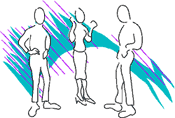Neuroscience For Kids
Why We "Feel" Nervousness
by Remi Alli (Neuroscience for Kids guest writer)
April 12, 2010
 Dutch researchers have an idea why people with social
anxiety disorder (SAD) blush more than others: they are afraid of how
others will judge them, and therefore become more nervous!
Dutch researchers have an idea why people with social
anxiety disorder (SAD) blush more than others: they are afraid of how
others will judge them, and therefore become more nervous!
 In experiments published in the journal Biological Psychology,
SAD blushers (n=32), SAD non-blushers (n=34), and healthy controls (n=25)
were placed in two social situations: 1) giving a speech in front of
strangers and 2) having a conversation with strangers. During these
tasks, blood flow to the cheek and forehead, cheek temperature, and skin
conductance were measured.
In experiments published in the journal Biological Psychology,
SAD blushers (n=32), SAD non-blushers (n=34), and healthy controls (n=25)
were placed in two social situations: 1) giving a speech in front of
strangers and 2) having a conversation with strangers. During these
tasks, blood flow to the cheek and forehead, cheek temperature, and skin
conductance were measured.
 The SAD blushers showed higher cheek temperatures and more blood flow
than SAD non-blushers and higher cheek temperatures than normal
control subjects. People with SAD who were non-blushers showed a smaller
increase in cheek blood flow during the interaction and no recovery
compared to the other groups. No differences in skin conductance
measurements between groups were observed.
The SAD blushers showed higher cheek temperatures and more blood flow
than SAD non-blushers and higher cheek temperatures than normal
control subjects. People with SAD who were non-blushers showed a smaller
increase in cheek blood flow during the interaction and no recovery
compared to the other groups. No differences in skin conductance
measurements between groups were observed.
 So, why do we "feel" nervousness? SAD patients may experience "feeling
nervousness," because their heart starts to race and blood rushes quickly
through their body. That's why the faces of some people with SAD get red
when they are embarrassed or nervous -- blood rushes to their faces.
Ultimately, our brain is not sure of what to do at that specific moment.
That is why we may feel shame when we accidentally burp out loud or trip
on the sidewalk in front of other people.
So, why do we "feel" nervousness? SAD patients may experience "feeling
nervousness," because their heart starts to race and blood rushes quickly
through their body. That's why the faces of some people with SAD get red
when they are embarrassed or nervous -- blood rushes to their faces.
Ultimately, our brain is not sure of what to do at that specific moment.
That is why we may feel shame when we accidentally burp out loud or trip
on the sidewalk in front of other people.
Nervousness usually happens when we are not fully prepared to handle a situation and it is generally based on our perception of the situation. These perceptions are called "cognitive distortions," and come from our feelings and how we perceive a situation.
References and more information:
- Voncken, M.J. and Bogels, S,M., Physiological blushing in social anxiety disorder patients with and without blushing complaints: two subtypes?, Biol Psychol., 81:86-94, 2009.
- Autonomic Nervous System - Neuroscience for Kids
Copyright © 1996-2010, Eric H. Chudler, University of Washington
